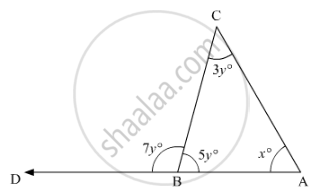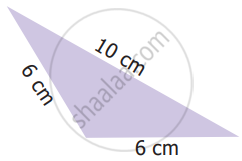Advertisements
Advertisements
Question
Which of the following statements are true (T) and which are false (F):
If the bisector of the vertical angle of a triangle bisects the base, then the triangle may be isosceles.
Solution
False (F)
Reason: The angular bisector of the vertex angle is also a median
⇒ The triangle must be an isosceles and also may be an equilateral triangle.
APPEARS IN
RELATED QUESTIONS
In a ΔABC, if ∠A=l20° and AB = AC. Find ∠B and ∠C.
Two lines AB and CD intersect at O such that BC is equal and parallel to AD. Prove that the lines AB and CD bisect at O.
ABC is a triangle in which ∠B = 2 ∠C. D is a point on BC such that AD bisects ∠BAC and AB = CD.
Prove that ∠BAC = 72°.
In ΔABC, if ∠A = 40° and ∠B = 60°. Determine the longest and shortest sides of the triangle.
Is it possible to draw a triangle with sides of length 2 cm, 3 cm and 7 cm?
In the given figure, what is the value of x?

The base BC of triangle ABC is produced both ways and the measure of exterior angles formed are 94° and 126°. Then, ∠BAC =
Which of the following correctly describes the given triangle?
In ∆ABC, AB = AC and ∠B = 50°. Then ∠C is equal to ______.
In triangles ABC and PQR, AB = AC, ∠C = ∠P and ∠B = ∠Q. The two triangles are ______.
